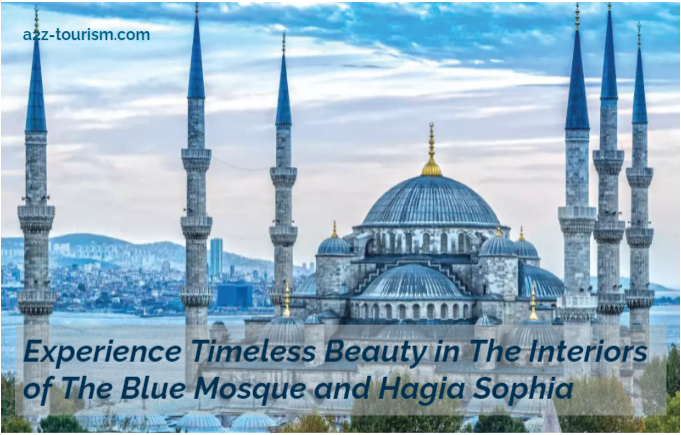Experience timeless beauty in the interiors of the Blue Mosque and Hagia Sophia officially known as the Sultan Ahmed Mosque, is a mesmerizing architectural treasure located in Istanbul, Turkey. Renowned for its intricate design, electric within, and iconic blue drains, the mosque stands as a confirmation of the rich history and artistic custom of the Ottoman Empire. Commissioned by Sultan Ahmed I in the early 17th century, the Blue Mosque has become an iconic corner and a must-visit destination for those seeking to immerse themselves in the architectural prodigies of Istanbul.
Its slinging polls, six minarets, and strictly drafted blue Iznik penstocks produce a visually stunning experience both on the surface and innards. Stepping outside, callers are saluted with over 20,000 handwrought ceramic penstocks generally in tones of blue, creating a serene and ethereal atmosphere. The intermediary pate, longhand, stained glass windows, and elegant design further enhance the mosque’s beauty. The Blue Mosque serves as a place of deification for the local Muslim neighborhood and welcomes visitors who wish to explore its architectural brilliance and experience its formless air.
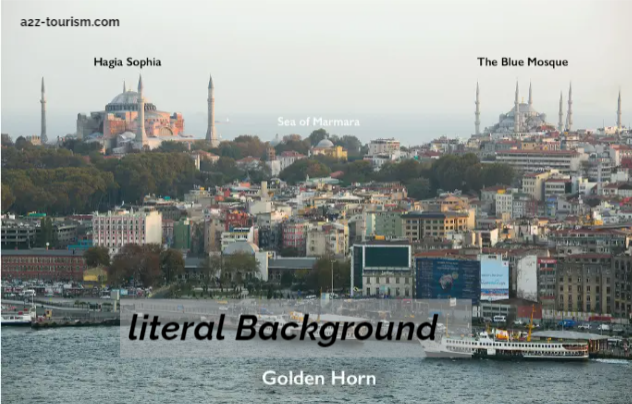
literal Background
The Sultan Ahmed Mosque was constructed between 1609 and 1616 during the reign of Sultan Ahmed I, who asked to make a synagogue that would surpass the near Hagia Sophia in majesty. The mosque was designed by the celebrated mastermind Sedefkar Mehmed Agha and stands as one of the last great architectural systems of the Ottoman Empire. The structure of the mosque wasn’t without debate, as it involved the obliteration of the ancient intricate Great Palace of Constantinople, which was seen by some as a symbol of the megacity’s history.
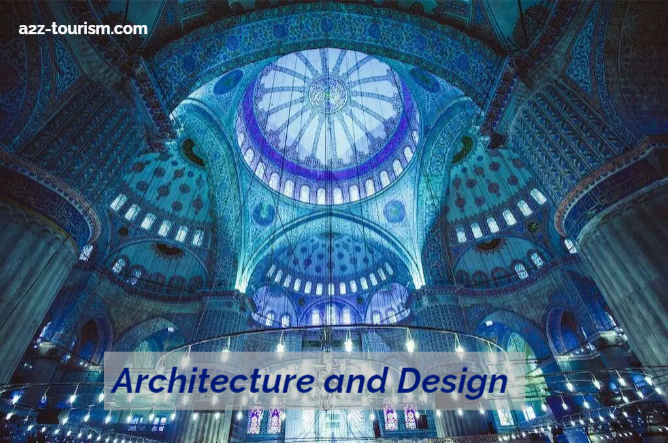
Architecture and Design
The architectural brilliance of the Sultan Ahmed Mosque is ostensive in its emotional design and delicate details. The mosque combines essentials of both elaborate and Islamic architectural styles, creating a solitary amalgam of artistic influences. The surface features slinging polls, six minarets, and semi-domes, all adorned with intricate blue Iznik penstocks, which give the synagogue its popular surname, the Blue Mosque.
The innards of the synagogue are inversely stirring. The main prayer hall is adorned with more than 20,000 handwrought ceramic penstocks, creating a serene and mesmerizing atmosphere. The mihrab, a niche indicating the direction of Mecca, is intricately sculpted with marble and plushly decorated with penmanship. The darkened glass windows permit natural light to refiner into the mosque, creating a tranquil air.
The yard, known as the” Sahn,” is vast and beautifully landscaped, featuring marble walkways and a central root. The six minarets, an oddity at the time of construction, add to the synagogue’s majesty and give a striking view from colorful edge points.

Significance and Cultural Impact
The Sultan Ahmed Mosque holds immense cultural and documentary denotation for both the original population and callers worldwide. As a religious point, it serves as an active synagogue where Muslims gather for diurnal prayers and congregational deification. The mosque’s capacity to take thousands of worshippers at a time is a confirmation of its consequence within the original Muslim community.
Beyond its devotional denotation, the Sultan Ahmed Mosque has become an enduring hallmark of Istanbul and a must-visit sightseer magnet. Its stunning armature and graphic position fashion it a popular destination for trippers seeking to immerse themselves in the city’s rich artistic heritage. The mosque’s accrual in Istanbul’s UNESCO World Heritage Site list further solidifies its status as a global crown jewel.
The Blue Mosque has likewise played an eloquent part in shaping the city’s blue and artistic identity. Its outline, with its slinging polls and minarets, has become an iconic symbol of Istanbul and is again and again featured in cards and journey leaflets. Also, the synagogue’s architectural rudiments and design have told posterior synagogue constructions not only in Turkey but also in other corridors of the world, leaving a lasting heritage on Islamic armature.
The Interior of the Blue Mosque
The within of the Blue Mosque is a confirmation of the architectural brightness and cultural mastership of its generators. As callers step into the mosque’s main prayer hall, they’re forthwith saluted with a sense of tranquility and majesty. The high ceilings, adorned with intricately painted patterns and longhand, produce an atmosphere of serenity.
One of the most conspicuous features of the Blue Mosque’s interior is the vast number of blue Iznik penstocks that cover the walls, giving the mosque its popular surname. These handmade drains, adorned with flowered matter and geometric figures, produce a mesmerizing optical display. The interplay of light and color, as sun pollutants through the stained glass windows, enhances the beauty of the funnels.
The central pate, with its fancy arrangements and exquisite penmanship, is a focal point of the mosque’s within. The pate is supported by elegant bends and columns, subjoining to the common sense of balance and poise. The mihrab, a niche betokening the direction of Mecca, is another remarkable point, drafted with marble and adorned with beautiful penmanship.
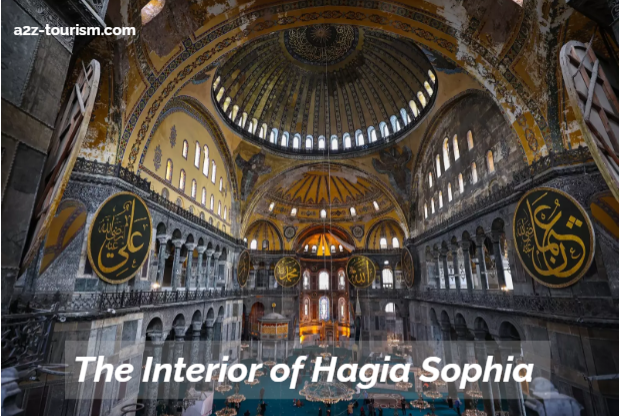
The Interior of Hagia Sophia
Hagia Sophia, a UNESCO World Heritage Site, is a confirmation of the architectural attainments of the intricate Conglomerate. Its mental exhibits a harmonious mix of intricate and Ottoman influences, reflecting the literal transitions that the structure has experienced.
The main nave of Hagia Sophia is a vast space that exudes a sense of wonder- inspiring majesty. The immense pate, supported by ponderous pendentives, seems to float painlessly above the space. The dome itself is adorned with mosaic patterns, depicting biblical backgrounds and figures, which add to the formless air of the interior
The walls of Hagia Sophia are adorned with intricate marble panels and large-scale mosaics. The mosaics, though incompletely covered during the Ottoman period, have been painstakingly restored, revealing their true splendor. These mosaics draw religious numbers, emperors, and locales from the life of Christ, showcasing the mastership of intricate art.
The within of Hagia Sophia likewise features magnificent marble queues and bends, adding to the architectural brilliance of the elbow room. The upper galleries give a solitary edge point to appreciate the hugeness of the interior and the intricate details of the mosaics and beautifiers.
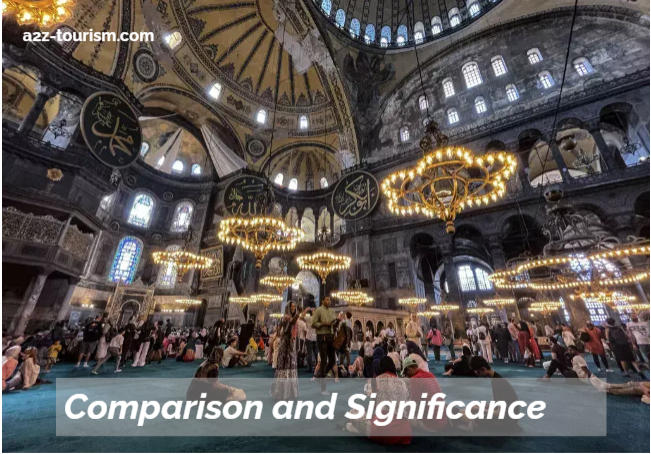
Comparison and Significance
The Blue Mosque and Hagia Sophia, located in close propinquity to each other, offer a fascinating discrepancy in architectural styles and literal significance. The Blue Mosque represents the apogee of the Ottoman edifice, while Hagia Sophia stands as a symbol of complex nobility.
The withins of both kirks are a comment on the artistic and religious customs that shaped their structure. The Blue Mosque’s interior showcases the fortune of the Ottoman Empire, with its lavish beautifier and complicated tile work. In discrepancy, Hagia Sophia’s interior combines the majesty of intricate mosaics with the simplicity and fineness of its architectural design.
Both mosques hold immense artistic and literal denotation. The Blue Mosque serves as a functional place of idolization, attracting Muslims from around humanity. Its within provides a hushed and formless space for prayer and meditation. Also, Hagia Sophia has transitioned from an intricate church to an Ottoman mosque and now serves as a gallery. Its intellectual offers visitors an eye into the rich history of Istanbul and the societies that have left their mark on the city.
Chronicle of the Blue Mosque
The structure of the Blue Mosque began in 1609 and was completed in 1616 during the reign of Sultan Ahmed I. The mosque was commissioned to compete with the majesty of the near Hagia Sophia, which had been a symbol of intricate glory. The famed mastermind Sedefkar Mehmed Agha designed the synagogue, incorporating rudiments of both intricate and Islamic architectural styles.
Architecture and Design
The Blue Mosque’s cadre is a masterpiece that blends grace and majesty. The shell boasts protruding polls, six minarets, and semi-domes, all adorned with intricate blue Iznik penstocks. These mains, accentuating flowery motifs and geometric patterns, give the mosque its cognomen and produce a stunning visual extravaganza.
The innards of the Blue Mosque are inversely witching. The main prayer hall is adorned with further than 20,000 handwrought ceramic penstocks, generally in tones of blue, creating a serene and mesmerizing atmosphere. The central pate, supported by four colossal pillars and adorned with penmanship, is a sight to behold. The darkened glass windows allow congenital light to sludge in, enhancing the incorporeal air.
Opening Hours and Callers’ Information
The Blue Mosque is open to callers every day, except during prayer times. It’s important to note that the synagogue is an active place of deification, and callers are anticipated to dress modestly and hypercritically. The opening hours may vary depending on prayer times and religious events, so it’s judicious to check the sanctioned website or sources for the most up-to-date information.
Exploring the Blue Mosque
Callers to the Blue Mosque can embark on a witching trip through its architectural prodigies. Upon entering, one is saluted by the vast yard, known as the” Sahn.” The yard is beautifully landscaped, featuring marble walkways and a central root, furnishing a serene air.
Inside the synagogue, callers can respect the stunning pipework, penmanship, and intricate designs. The mihrab, indicating the direction of Mecca, is intricately sculpted with marble and adorned with beautiful penmanship. The gallery above the main prayer hall offers a solitary perspective, allowing callers to appreciate the majesty of the interior.
The Significance of the Blue Mosque
The Blue Mosque holds immense artistic and literal significance. As an active place of deification, it serves as a spiritual center for the original Muslim community. Its real estate to accommodate thousands of worshippers at a time is a confirmation of its importance within Istanbul.
Also, the Blue Mosque has become a symbol of Istanbul’s rich artistic heritage and a major sightseer magnet. Its architectural brilliance, stunning innards, and pictorial position fashion it a must-visit destination for rubberneckers. The mosque’s addition to Istanbul’s UNESCO World Heritage Site list further underscores its global significance.
Conclusion
The Blue Mosque, with its amazement-inspiring fabric, mesmerizing innards, and rich literal backdrop, stands as a confirmation of Istanbul’s artistic heritage. Its complicated design, blue penstocks, and majesty continue to lure visitants from around the world. Exploring the Blue Mosque allows callers to immerse themselves in the rich history and architectural sensations of the Ottoman Empire. Whether one is drawn by the architectural brilliance, the spiritual air, or the desire to witness an artistic treasure, a visit to the Blue Mosque is an indelible experience. Standing in its presence, one can not help but marvel at the beauty and literal significance of this iconic corner in Istanbul.
Hagia Sophia and the Blue Mosque are two separate architectural milestones in Istanbul. Hagia Sophia, firstly an intricate edifice, is now a gallery and is famed for its massive pate and literal significance. The Blue Mosque, on the other hand, is an active synagogue and one of the most important religious spots in Istanbul. While both structures are significant and attract callers due to their architectural beauty, they’ve distinct histories, purposes, and architectural styles.
FAQs
What’s special about the Blue Mosque?
The Blue Mosque, likewise grasped as the Sultan Ahmed Mosque, is famed for its stunning skeleton, fancy design, and witching interior. It’s one of the most notorious kirks in Turkey and a significant corner of Istanbul. The mosque’s surface boasts slinging polls, six minarets, and semi-domes adorned with complicated blue Iznik penstocks, giving it a distinct and mesmerizing appearance. The innards of the Blue Mosque are inversely electric, featuring further than 20,000 handwrought ceramic penstocks generally in tones of blue, hence its surname. The central pate, penmanship, stained glass windows, and elegant design produce a serene and ethereal atmosphere, making the Blue Mosque a must-visit destination for excursionists and a hallowed place of deification for the original Muslim community.
Is Hagia Sophia and Blue Mosque the same?
Yes, it’s free to enter the Blue Mosque. As an active synagogue, the Blue Mosque welcomes callers who wish to explore its innards and respect its architectural prodigies. still, callers are anticipated to dress modestly and hypercritically, and it’s judicious to visit outside the prayer times. Donations are accepted to help with the conservation and preservation of the mosque.
Is it free to enter the Blue Mosque?
Yes, it’s free to enter the Blue Mosque. As an active synagogue, the Blue Mosque welcomes callers who wish to explore its innards and respect its architectural prodigies. still, callers are anticipated to dress modestly and hypercritically, and it’s judicious to visit outside the prayer times. Donations are accepted to help with the conservation and preservation of the synagogue.
Who’s buried in the Blue Mosque?
There are several sepultures located within the Blue Mosque complex, but the most well-known grave is the burial place of Sultan Ahmed I, the synagogue’s namesake. Sultan Ahmed I, who commissioned the construction of the synagogue, is buried in a grand tomb conterminous to the synagogue. The mausoleum is accessible from within the mosque and is a place of reverence and memory for the Ottoman sultan.
Which synagogue were 70 prophets buried?
The synagogue associated with the burial of 70 prophets is the Mosque of Al-Masjid al-Nabawi in Medina, Saudi Arabia. According to Islamic custom, the Mosque of the Prophet, as it’s also called, is credited to house the sepultures of several prophets, embracing Prophet Muhammad himself, as well as Abu Bakr and Umar, the first and alternate caliphs of Islam. The mosque holds immense spiritual significance for Muslims worldwide and is a major passage point.
Why is the Blue Mosque called the Blue Mosque?
The Blue Mosque gets its surname from the intricate blue Iznik penstocks that beautify its innards. These penstocks, generally in tones of blue, have been strictly drafted and painted by professed crafters. The blue color symbolizes the welkin and creates a serene and ethereal atmosphere within the synagogue. The interplay of light through the stained glass windows further enhances the blue tinges, giving the synagogue its unique and witching appearance.

